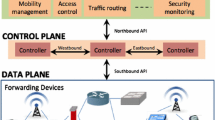Abstract
It is convenient to describe telecomms services using a graphical notation that is accessible to non-specialists. However, the notation should also have a formal interpretation for rigorous analysis. Cress (Chisel Representation Employing Systematic Specification) has been developed for this purpose. A brief overview of Cress is given. It is explained how features (additional services) can be defined in a modular fashion, and automatically combined with a base service. Brief case studies illustrate how the approach has been used to describe services in the IN (Intelligent Network), SIP (Session Initiation Protocol), and IVR (Interactive Voice Response). Finally, it is shown how Cress diagrams are translated into SDL for automated simulation, validation and implementation.
Access this chapter
Tax calculation will be finalised at checkout
Purchases are for personal use only
Preview
Unable to display preview. Download preview PDF.
Similar content being viewed by others
References
E. J. Cameron, N.D. Griffeth, Y.-J. Lin, M. E. Nilson, W.K. Schnure, and H. Velthuijsen. A feature-interaction benchmark for IN and beyond. IEEE Communications Magazine, pages 64–69, Mar. 1993.
A.V. Aho, S. Gallagher, N.D. Griffeth, C.R. Schell, and D.F. Swayne. SCF3/Sculptor with Chisel: Requirements engineering for communications services. Proc. 5th. Feature Interactions in Telecommunications and Software Systems, pages 45–63. IOS Press, Amsterdam, Netherlands, Sept. 1998.
ITU. Specification and Description Language. ITU-T Z.100. International Telecommunications Union, Geneva, Switzerland, 2000.
ISO/IEC. Information Processing Systems — Open Systems Interconnection — LOTOS — A Formal Description Technique based on the Temporal Ordering of Observational Behavior. ISO/IEC 8807. International Organization for Standardization, Geneva, Switzerland, 1989.
ITU. Intelligent Network — Q.120x Series Intelligent Network Recommendation Structure. ITU-T Q.1200 Series. International Telecommunications Union, Geneva, Switzerland, 1993.
J. Rosenberg, H. Schulzrinne, G. Camarillo, A. Johnson, J. Peterson, R. Sparks, M. Handley, and E. Schooler, editors. SIP: Session Initiation Protocol. RFC 3261. The Internet Society, New York, USA, June 2002.
V. Forum. Voice eXtensible Markup Language. VoiceXML Version 1.0. VoiceXML Forum, Mar. 2000.
ITU. Message Sequence Chart (MSC). ITU-T Z.120. International Telecommunications Union, Geneva, Switzerland, 2000.
K. J. Turner. Formalizing the Chisel feature notation. Proc. 6th. Feature Interactions in Telecommunications and Software Systems, pages 241–256, Amsterdam, Netherlands, May 2000. IOS Press.
K. J. Turner. Modelling SIP services using Cress. In D.A. Peled and M.Y. Vardi, editors, Proc. Formal Techniques for Networked and Distributed Systems (FORTE XV), number 2529 in Lecture Notes in Computer Science, pages 162–177. Springer-Verlag, Berlin, Germany, Nov. 2002.
N.D. Griffeth, R. B. Blumenthal, J.-C. Gregoire, and T. Ohta. Feature interaction detection contest. Proc. 5th. Feature Interactions in Telecommunications and Software Systems, pages 327–359. IOS Press, Amsterdam, Netherlands, Sept. 1998.
J. Lennox and H. Schulzrinne. Feature interaction in internet telephony. Proc. 6th. Feature Interactions in Telecommunications and Software Systems, pages 38–50, Amsterdam, Netherlands, May 2000. IOS Press.
Author information
Authors and Affiliations
Editor information
Editors and Affiliations
Rights and permissions
Copyright information
© 2003 Springer-Verlag Berlin Heidelberg
About this paper
Cite this paper
Turner, K.J. (2003). Formalizing Graphical Service Descriptions Using SDL. In: Reed, R., Reed, J. (eds) SDL 2003: System Design. SDL 2003. Lecture Notes in Computer Science, vol 2708. Springer, Berlin, Heidelberg. https://doi.org/10.1007/3-540-45075-0_11
Download citation
DOI: https://doi.org/10.1007/3-540-45075-0_11
Published:
Publisher Name: Springer, Berlin, Heidelberg
Print ISBN: 978-3-540-40539-9
Online ISBN: 978-3-540-45075-7
eBook Packages: Springer Book Archive




